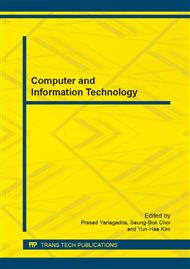[1]
Yunhong Wang, Yong Zhu, Tieniu Tan: Acta Automatica Sinica, Vol. 28, No. 1 (2002), pp.1-10. (In Chinese).
Google Scholar
[2]
Daugman J: IEEE Transact ions on Pattern Analysis and Machine Intelligence, Vol. 15, No. 11 (1993), pp.1148-1161.
Google Scholar
[3]
Wildes Richard P.: Proceedings of the IEEE, Vol. 85, No. 9 (1997), pp.1348-1363.
Google Scholar
[4]
W W Boles, B Boashash: IEEE Transactions on Signal Processing (S1053-587X), Vol. 46, No. 4 (1998), pp.1185-1188.
DOI: 10.1109/78.668573
Google Scholar
[5]
Ganeshan Balaji, Theckedath Dhananjay, Young Rupert, Chatwin Chris: Optics and Lasers in Engineering (S0143-8166), Vol. 44, No. 1 (2006), pp.1-24.
DOI: 10.1016/j.optlaseng.2005.03.010
Google Scholar
[6]
Xueyi Ye, Zhenquan Zhuang, Peng Yao, Fei Long: Journal of Image and Graphics: A, Vol. 10, No. 3 (2005), pp.305-309. (In Chinese).
Google Scholar
[7]
Xinhua Feng, Xiaoqing Ding, Chi Fang, Youshou Wu: Journal of Tsinghua University (Science and Technology), Vol. 47, No. 1 (2007), pp.80-83. (In Chinese).
Google Scholar
[8]
Qiongyao Zhu: Computer Engineering and Applications, Vol. 49, No 8 (2013), pp.182-184. (In Chinese).
Google Scholar
[9]
Qian Chen, Sujing Wang, Xiaohua Liu, Lei Gao, Chunguang Zhou: Journal of Jilin University(Science and Technology), Vol. 49, No. 6 (2011), pp.1095-1100. (In Chinese).
Google Scholar
[10]
Qichuan Tian, Quan Pan, Yan Liang, Yongmei Cheng, Hongcai Zhang: Journal of System Simulation (S1004-731X), Vol. 18, No. 7 (2006), pp.1777-1780. (In Chinese).
Google Scholar
[11]
K. W. Nam, K. L. Yoon, W. S. Yang. A feature extraction method for binary iris code construction [C]. Proceedings of the 2nd International Conference on Information Technology for Application (ICITA 2004), Harbin, (2004), pp.284-287.
Google Scholar
[12]
Xia Li, Luyi Yu, Na Wang: Journal of Computer-aided Design & Computer Graphics, Vol. 18, No. 8 (2006), pp.1155-1159. (In Chinese).
Google Scholar
[13]
Lei Xia, Chao Cai, Chengping Zhou, Mingyue Ding: Application Research of Computers, Vol. 24, No. 10 (2007), pp.197-199. (In Chinese).
Google Scholar
[14]
Tian Qichuan, Li Ziliang, Liu Xirong, Li Linsheng: Journal of System Simulation, Vol. 21, No. S2 (2009), pp.222-225. (In Chinese).
Google Scholar
[15]
Nian Liu, Hang Su, Chunhong Guo, Jing Zhou: Computer Engineering and Design, Vol. 32, No. 4 (2011), pp.1359-1362. (In Chinese).
Google Scholar


